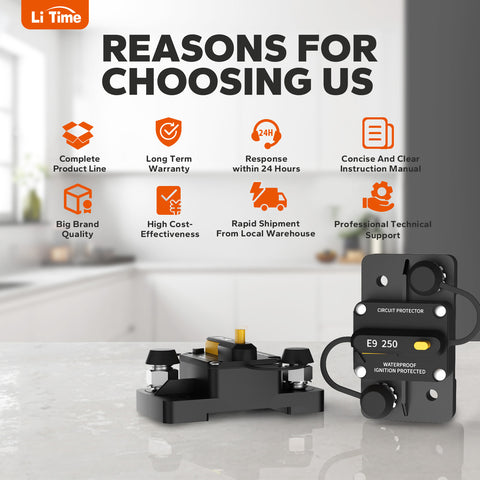LiTime 250A Switchable Circuit Breaker for LiFePO4 Batteries
【Safety and reliability】 The 250A Switchable Circuit Breaker can effectively protect the LiFePO4 battery and circuit from overloading, short circuits, and other electrical faults, ensuring safety and reliability during use.
【High-quality materials】 The product is made of high-quality materials with excellent durability and oxidation resistance, which can meet the long-term use requirements.
【Easy to use】 The 250A Switchable Circuit Breaker is easy to install and operate without professional skills, allowing users to get started quickly.
【Wide applicability】 The product is suitable for various LiFePO4 batteries and can be widely used in automobiles, ships, solar panels, and other fields to meet the needs of different users.
【Energy-saving and environmentally friendly】 LiFePO4 batteries have the characteristics of efficient energy-saving and environmental protection. When used in conjunction with the 250A Switchable Circuit Breaker, their advantages in energy-saving and environmental protection can be fully realized.
- $39.99
-
$55.99 - $39.99
- Unit price
- per
Please hurry! Only 73 left in stock
Subtotal:
$39.99
Couldn't load pickup availability
Free Shipping
Free standard shipping on all orders
Estimated to be delivered within 2-5 business days.
1 Year Warranty
Backed up by technical support within 24hrs.
Free Returns
30 Days Hassle Free
Returns
-
FEATURES
-
FAQ
-
REVIEWS
FAQ
Q: What is a circuit breaker?
A:
A circuit breaker is an electrical switching device designed to protect an electrical circuit from damage caused by overload, short circuit, or other electrical faults. It automatically interrupts the flow of electricity when a fault is detected.
Q: How does a circuit breaker work?
A:
When an overcurrent or fault occurs in the electrical circuit, the circuit breaker's internal mechanism detects the abnormal condition and triggers a trip signal. This causes the circuit breaker to open, interrupting the flow of electricity and protecting the circuit and connected devices.
Q: What are the differences between circuit breakers and fuses?
A:
Circuit breakers and fuses both provide overcurrent protection, but they operate differently. Circuit breakers can be reset after tripping, while fuses must be replaced. Additionally, circuit breakers offer better protection against short circuits and can be more convenient in some applications.
Q: How should circuit breakers be selected for specific applications?
A:
When selecting circuit breakers, factors such as the type of load, the maximum fault current, voltage rating, and environmental conditions should be considered. Proper coordination with other protective devices in the electrical system is also important.
REVIEWS
Related Products
LiTime
Example product title
- $39.99
-
$55.99 - $39.99
- Unit price
- per
LiTime
Example product title
- $39.99
-
$55.99 - $39.99
- Unit price
- per
LiTime
Example product title
- $39.99
-
$55.99 - $39.99
- Unit price
- per
LiTime
Example product title
- $39.99
-
$55.99 - $39.99
- Unit price
- per
LiTime
Example product title
- $39.99
-
$55.99 - $39.99
- Unit price
- per
LiTime
Example product title
- $39.99
-
$55.99 - $39.99
- Unit price
- per
LiTime
Example product title
- $39.99
-
$55.99 - $39.99
- Unit price
- per
LiTime
Example product title
- $39.99
-
$55.99 - $39.99
- Unit price
- per
LiTime
Example product title
- $39.99
-
$55.99 - $39.99
- Unit price
- per
LiTime
Example product title
- $39.99
-
$55.99 - $39.99
- Unit price
- per
- Choosing a selection results in a full page refresh.

















































































































































